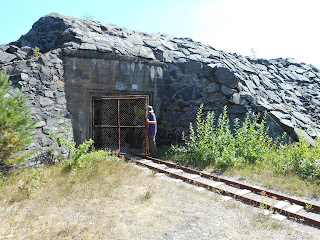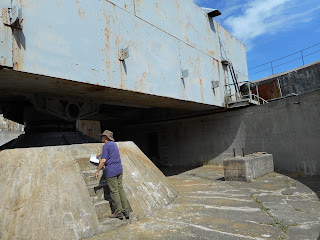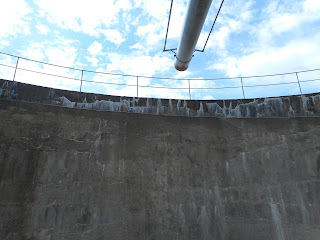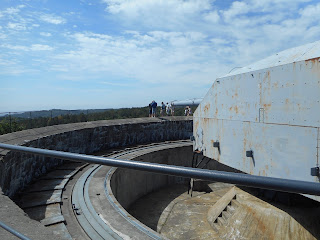‘There’s a
beautiful valley you could explore,’ said my aunt as we sat outside eating
breakfast on another scorching day.
‘Mmm,’ said Frog and I. We’d done beauty
the day before.
‘Or’, continued my aunt, ‘just near here
there’s a German fort.’
‘Yes,’ we said as one.
My aunt led us
there in her car.
‘On your way back’, she said as she left us
in the carpark, ‘look out for an island with a prison. During
the war the prison was full of Russians and, at the end of the war when the
Germans left, they starved to death.’
She looked grim which made me think it was
the Norwegians’ fault but then a lot of the Norwegians had starved too. People who lived by the sea had fish, but otherwise according to my mother ‘they
had nothing to eat but mushrooms’.
Frog and I put our hats on and climbed a
path through dappled shade. A concrete building loomed.
Close up the
building was even more ominous.
‘It’s 90 krone to visit the museum,’ explained
a young woman behind a table at the top of the path, pointing to the building.
‘The rest is free.’
I’m not keen on museums but it seemed
churlish to refuse, so we paid our 180 krone (£18), receiving in return
leaflets in English. Then, leaving behind the sun and the warmth, we entered
the dark dank building.
The first thing I saw was a swastika
painted on a wall.
My god, I thought. They really were here.
Frog made us
visit the rooms in order - the radio room, the air-conditioning room, the
cooling water room, the generator, the diesel tanks, the emergency barracks –
while he read out information from the leaflet, but I hardly listened. I was
lost in something like horror.
We could walk right up to the machines and
touch them. Everything seemed to have been left just as it was 75 years ago,
ready for re-use if necessary. This wasn’t a museum: it was a war film come to
life. I could hear the leather boots clanging on the metal floor, and the harsh German
commands bouncing off the stone walls. The Guns of Navarone said Frog.
The leaflet
brought us to the rotunda where the shells were loaded and to the gun itself. Again,
there were no restrictions as to where we could go and we climbed all over.
I was aghast at
the scale and precision of the engineering and at the way everything was
planned down to the last detail so that the whole thing ran like clockwork. And all for killing.
I left Frog to
it and went out into the sunshine. Here, the gun looked almost worse as you could see its size.
But the views
were fabulous.
Most historical sites disappointed but this one - like the Parthenon in Athens - far exceeded my expectations. It was outstanding in every way.
I read the
glossy leaflet and discovered that the gun is the second biggest in the world
with a range of 55 kilometres. It was built to guard the Skagerrak, the sea
channel between Denmark and Norway that gives access to the Baltic (and the German coast). There was a
twin gun in Denmark.
From a map in
the glossy leaflet
I also
discovered that the ‘cannon museum’ was part of a complex of barracks,
ammunition stores, anti-aircraft-gun bunkers, another cannon building, a pigsty, a
smithy, a sports field, a mess, a sick bay, a water reservoir. All built by
Germans, Norwegians and Russian prisoners.
Frog
reappeared and we set off to explore – in completely the wrong direction. Frog
took a quick look at what we had by now calculated was an anti-aircraft-gun
bunker
and then we
tried to retrace our footsteps. Except that we missed the path. It was turning out
to be my sort of walk.
We sat on a
rock and shared an apple my aunt had pressed on us. Next to us a rowan sapling grew
out of a discarded piece of German concrete like a sign of hope.
Through the
trees we glimpsed the deep blue of the sea.
With the heat and the colours and the scent of pine, we could have been in Greece. I’d always
said that Greece reminded me of Norway – mountains and islands - and now Norway was reminding me of Greece. Then I
remembered another similarity. Both had been occupied by the Germans during the
war and both still talked about it.
Back on course
we approached a second gun building whose gun had been sunk on its way and so never
installed. It looked like a monument to Fascism.
As we neared the building I could see swallows streaming in and out. Another sign of hope I thought, but I didn't want to go inside the building.
We climbed up
and down, over and around, looking at bunkers, buildings and ruins. I looked at the wildflowers too, which were doing their best to recolonise the area.
 |
| I think this is a wildflower not a garden escape but I haven't yet identified it. I saw it everywhere, not just at the fort. |
Then we went
wrong again. Was it us or was the map at fault? Never mind. It meant we
missed the other people (all two of them) and approached buildings from the
back, where we could squeeze in to have a look. Or Frog could. If there was any
doubt about getting out again, I preferred to stay away so as to get help if
necessary. I couldn’t stop thinking about those Russian prisoners.
 |
| Frog entering a bunker for the storage of shells |
A railway,
built to transport shells from the bunkers to the gun, still ran around the
site.
I knew that the
train, which now took visitors around, wasn’t original, but it still gave me a
shudder when it came up behind us.
We used the
railway to find our way back to the museum entrance where we sat at a picnic
table and took stock. We’d spent three hours at the site.
‘Did you like it?’ asked the young woman at
the ticket table.
‘It was amazing,’ I said. ‘It made the war
so real.’
The woman looked shocked, as if I shouldn’t
have mentioned the war.
‘Where are you from?’ she asked.
‘England,’ we said.
‘Oh,’ she said, surprised. ‘Most of our foreign visitors are German. We hardly ever get English people here.’
I spotted the
prison island on our drive back. Half in ruins, the prison covered the island. It
was the same colour as the rock and appeared to be growing from the sea. No effort had been made to tidy it up or remove it. It looked sad and lonely and grotesque, like something from Gormenghast.
The leaflet had called the German fort a ‘Memorial to Barbarity’. Here was another.
The leaflet had called the German fort a ‘Memorial to Barbarity’. Here was another.
















No comments:
Post a Comment
Your comment won't be visible immediately. It comes to me first (via email) so that I can check it's not spam. I try to reply to every comment but please be assured that, even if I don't, every genuine comment is read with interest and greatly appreciated. Thank you!